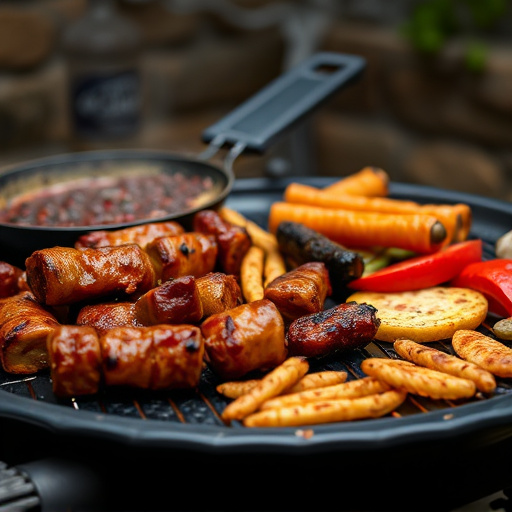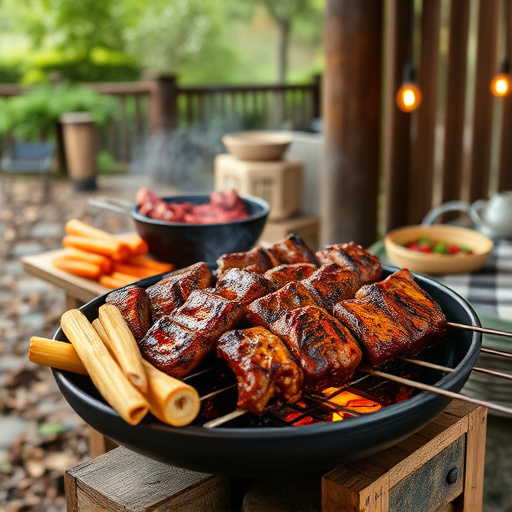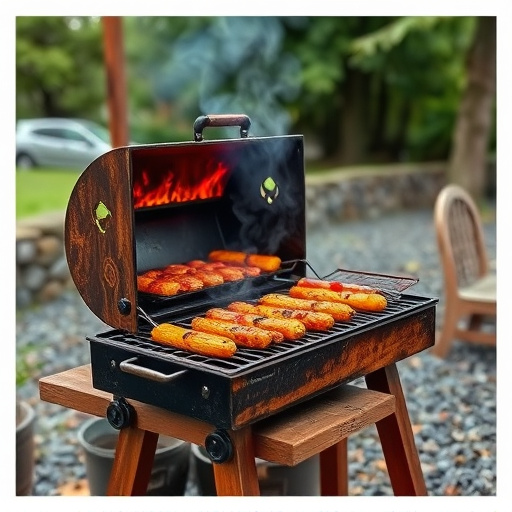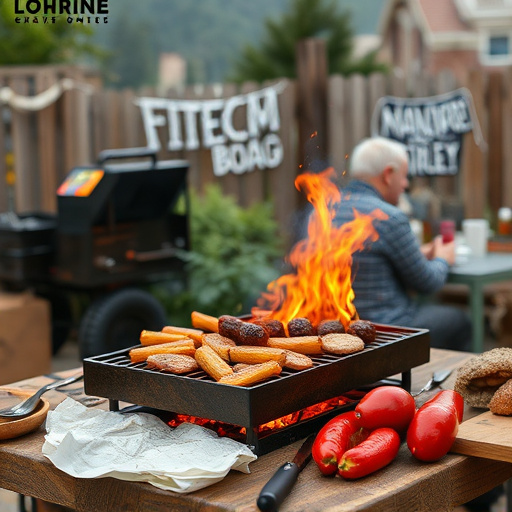This Easy BBQ Brisket Recipe guides you through selecting, preparing, and cooking a tender, smoky beef brisket at home using simple techniques and specific tools. Start with a high-quality, well-marbled packer brisket, season it, and cook it slowly over low heat to break down collagen into gelatin for a meltingly soft texture. Use a Dutch oven or smoking container, digital thermometer, sharp knife set, and butcher's rope for optimal results. Achieve restaurant-quality brisket by smoking at 225°F/107°C for 4-5 hours, wrapping it in foil, and continuing cooking until tender with an internal temperature of 203°F (95°C).
Discover how to make restaurant-quality brisket in your own kitchen with our comprehensive guide. We’ll walk you through the science behind smoking brisket, provide essential tools and techniques, and share an easy BBQ brisket recipe for perfect results every time. Learn tips and tricks from experts to achieve that coveted, tender, smoky flavor without leaving home.
- Understanding Brisket: Cut, Texture, and Taste
- Essential Tools and Equipment for Perfect Brisket
- The Science Behind Smoking Brisket
- Easy BBQ Brisket Recipe: Step-by-Step Guide
- Tips and Tricks for Achieving Restaurant-Quality Results at Home
Understanding Brisket: Cut, Texture, and Taste

Brisket, a cut from the breast of a beef cattle, is renowned for its tender texture and rich, smoky flavor when cooked slowly over low heat. When preparing an Easy BBQ Brisket Recipe at home, understanding the brisket’s unique properties is key to achieving restaurant-quality results. The ideal brisket has a thick layer of fat marbling that not only keeps it moist during slow cooking but also contributes to its succulent taste.
The cut itself offers various options for preparation. Traditionally, brisket is cooked whole, but it can also be sliced into thin strips (point cuts) or pulled apart in chunks (flat cuts). Each method yields a distinct texture and flavor profile—whole brisket provides a hearty, robust meal, while pulled brisket offers a more delicate experience, perfect for sandwiches. The secret to unlocking the full potential of your Easy BBQ Brisket Recipe lies in slow cooking, allowing the collagen in the meat to break down into gelatin, resulting in tender, almost meltingly soft brisket.
Essential Tools and Equipment for Perfect Brisket

Achieving restaurant-quality brisket at home is an art, and the right tools are essential to master this technique. For the ultimate Easy BBQ Brisket Recipe, invest in a good quality, heavy-duty Dutch oven or smoking container. This will provide the perfect environment for slow cooking and smoking, ensuring even heat distribution and moist, tender meat. A reliable thermometer is another must-have; digital probes are handy as they allow you to monitor the temperature without opening the container, maintaining humidity levels.
Don’t forget the importance of a sharp knife set, especially a good boning knife for slicing the brisket thinly. You’ll also need a butcher’s rope or twine to tie the meat tightly, ensuring even cooking and preventing it from drying out. These tools, combined with your culinary skills, will have you serving up mouth-watering, restaurant-style brisket in no time!
The Science Behind Smoking Brisket

The art of smoking brisket is a blend of precise science and patient cooking. This easy BBQ brisket recipe relies on understanding the meat’s structure and the chemical reactions that occur during the slow-cooking process. Brisket is a muscle, rich in connective tissues, which break down into delicious, tender fibers when exposed to low, moist heat. The smoking process enhances these flavors, with the heat from the smoke gently transforming the brisket over hours or even days.
Time and temperature are key factors in achieving restaurant-quality brisket at home. The right wood chips or chunks, like oak or hickory, infuse the meat with a subtle, smoky taste. Maintaining a consistent temperature between 225°F to 250°F (107°C to 121°C) ensures slow, even cooking. This low-and-slow method allows the brisket’s natural juices to remain locked in, keeping it moist and preventing tough, dry meat.
Easy BBQ Brisket Recipe: Step-by-Step Guide

To make restaurant-quality brisket in your kitchen, follow this easy BBQ brisket recipe. Start by selecting a high-quality, well-marbled packer brisket with a good fat cap. This ensures even cooking and rich flavor. Preheat your oven to 275°F (135°C) and season both sides of the brisket generously with a dry rub consisting of salt, pepper, garlic powder, and paprika. Place the meat in a large roasting pan and cover it tightly with aluminum foil. The initial slow cooking at a low temperature helps break down tough connective tissues, making the final result tender and juicy.
After 4-5 hours, remove the foil and increase the oven temperature to 350°F (175°C). This step is crucial for developing a crispy crust. Brush the brisket with your favorite BBQ sauce and continue cooking until the exterior is nicely charred and the internal temperature reaches 203°F (95°C) for medium-rare doneness. Let the meat rest for at least an hour before slicing against the grain to achieve maximum tenderness. Serve with sides of your choice, such as creamy coleslaw or baked beans, and enjoy your homemade restaurant-quality brisket!
Tips and Tricks for Achieving Restaurant-Quality Results at Home

Achieving restaurant-quality brisket at home is within reach with a few simple tips and tricks. First, choose the right cut—look for a well-marbled packer brisket with good fat cap. This ensures even cooking and rich flavor. Next, trim excess fat to about 1/4 inch, leaving enough to keep the meat moist during slow cooking.
Seasoning is key; use a simple rub of salt, pepper, garlic powder, and paprika for maximum flavor. For an easy BBQ brisket recipe, start by smoking at a low temperature (225°F/107°C) for 1 to 1.5 hours per pound until it reaches an internal temperature of 165°F/74°C. Then, wrap the meat tightly in foil and continue cooking until tender and easily shreddable—a process known as “resting.” This allows the juices to redistribute, ensuring a juicy, flavorful brisket every time.
